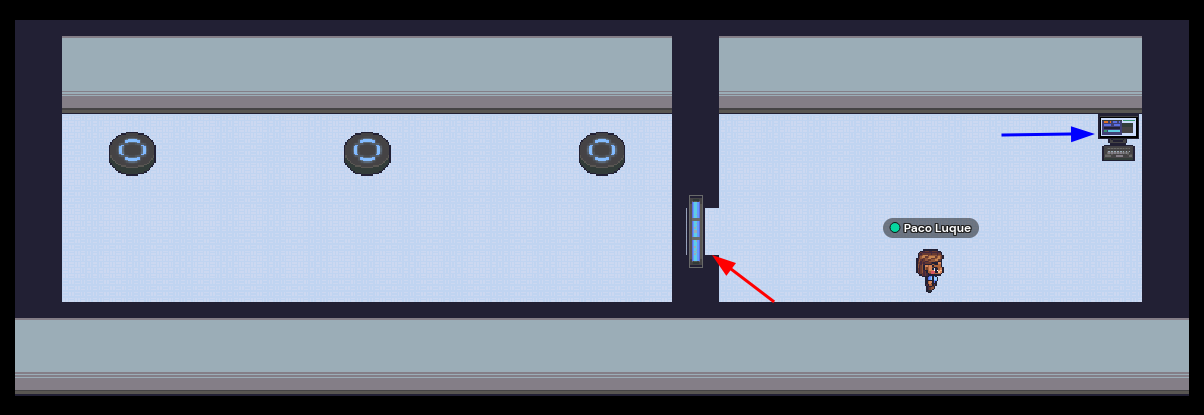This repository contains the source code and assets developed for our research project about mathematical communication. In it, we propose an activity based on a Escape Room whose aim is to improve the mathematical communication among our students.
The game is developed using the platform . This platform aims to convert virtual interactions
into a more human experience. To that purpose, they offer a website with
capability to create virtual spaces where attendants can interact with each
other and the surroundings. Moreover, they provide an (still experimental) API

We leverage the flexibility of the platform and the API they provide to build an interactive activity for our students. The activity is prepared to be played by a group of 3 students, and it is composed of 5 tasks, ordered by ascending difficulty.
This repository provides all the information you need to setup the activity with your own students.
The proposed activity is an escape room composed of 5 tasks. Tasks are ordered in ascending difficulty, and they are tackled in a sequential manner. In order to improve the communication capabilities of our students, the game is built in such a way that players' paths are disjoint. Once the escape room starts, each player will be teleported to an independent room, and they will not be able to visit the rooms of their partners (although they can see each other in the screen). The information needed to solve the problems will be then presented in a fragmented way, and each player will find only a fragment of the information needed to solve the task. Thus, they will have to communicate their information to each other to solve the assignment properly. Without this communication, the problems are not solvable, since every piece of information is relevant to the task.
The students' workflow during the activity is pretty straightforward. They will find each task subsequently, and the path to continue will be blocked by a door that can be opened by solving the current task. After they have solved it, a computer accessible by one of the students will ask for the solution. If the provided solution is correct, the doors of the three participants will unlock and they will be able to go on to the next assignment. Their objective is to escape from the building, whose exit is placed after the fifth task.
An example of the escape room can be found
. Feel
free to roam around the game and interact with the objects to grasp the
intention of the activity. When you are finished, go to the master controls
section to reset the room for the next visitor.
DISCLAIMER: Problem statements are written in spanish (our mother tongue). However, it should not be difficult to modify the code to translate it into other languages.
Gather town spaces are composed of rooms. Rooms in the space are connected so you can travel from one room to another by moving in the space. In our case, there are 8 rooms:
explanation_room: It is the landing room of the space. By default, the first time somebody enters in our space, will appear in this room. It is connected using teleports to the three starting rooms for the players. It also contains a restricted area (locked using a password door), where the computer with the game master controls is placed. We will specify the master controls and how to use them later.first_room_{1,2,3}: Three identical copies of the room where the players start the game. Each player starts the game in one of those rooms. They will access them after the teacher explanation using the portals in the explanation room. These rooms are connected to theproblems_1_2room, where the students will confront the first two tasks. The connecting door is closed, and can be unlocked by answering a simple question in the room computer. This simple interaction seeks to teach the students on how to interact with the engine in a simple manner. Also, in the room there is a walkie-talkie that opens a Google Meet call. Students can use this call to communicate to each other. Since Gather Town only allows to communicate with other participants that are close to us, and we have placed the students in different rooms, we need to provide this external communication method to them.problems_1_2: In this room, the first two problems are proposed. The room is separated in three paths, one for each student, and each path is separated in two parts by a locked door. In the first part, the first problem is proposed. After it is solved, the door is unlocked, and the second part of the room is accessible. In the second part lies the second problem of the activity. After it is solved, a door to visit the next room is unlocked for each player.problems_3_4: As in the previous case, this room is divided in three paths, each one with two parts separated by a door. In each part, one problem is given. Upon completion, each problem opens a door. Problem 3 opens the door to the second part of the room, problem 4 opens the door to next room.problem_5: This room proposes the last problem of the game. The first part of this room is separated in three paths, as it was in previous rooms. In the second part of the room, paths of the three players come together, and the door to the outside of the building can be found. Those two parts are separated by doors, as in the other problems.outside: This is the last accessible room of our game. Players will get to it when they have solved all the problems.
Players can travel from one room to the other using the doors they will find during the game. The only point where returning is not allowed is between the explanation room and the first rooms, since we want to enforce each player not to visit their mates' paths. However, if one player accidentally steps into the wrong portal, it is possible to respawn to the explanation room using the "Respawn" button in Gather Town menu.
In this section, the structure of the repository is outlined. You can find more information about each subpart by visiting the file README.md inside each of the folders.
room_scenarios_assets: In this folder, the image files that define the different scenarios in the game are given. In the corresponding README, some indications about the files and the tools used to create them are given.code: In this folder, the source code implemented to deploy the objects in the space and provide them interactivity is stored. In the corresponding README, and in-depth explanation of the code and how to run it is given.exercise_materials: In this folder, the additional materials prepared for the game are stored. In the README, an explanation on how to make that information available to the players is given.
In order to use this activity with your students, you will have to follow a series of steps to have your own instance of the game running. This steps have been tested on a Linux machine (specifically, using Ubuntu 20), but most of them should be equivalent in other operative systems. Feel free to open an issue if you find any problem, and I will try to answer as soon as possible.
- Create an account in Gather Town.
- Create a blank space, choose a name and a purpose and press "Create Space"



- Enter into MapMaker tool by selecting the editing tool and choosing "Edit
in MapMaker"
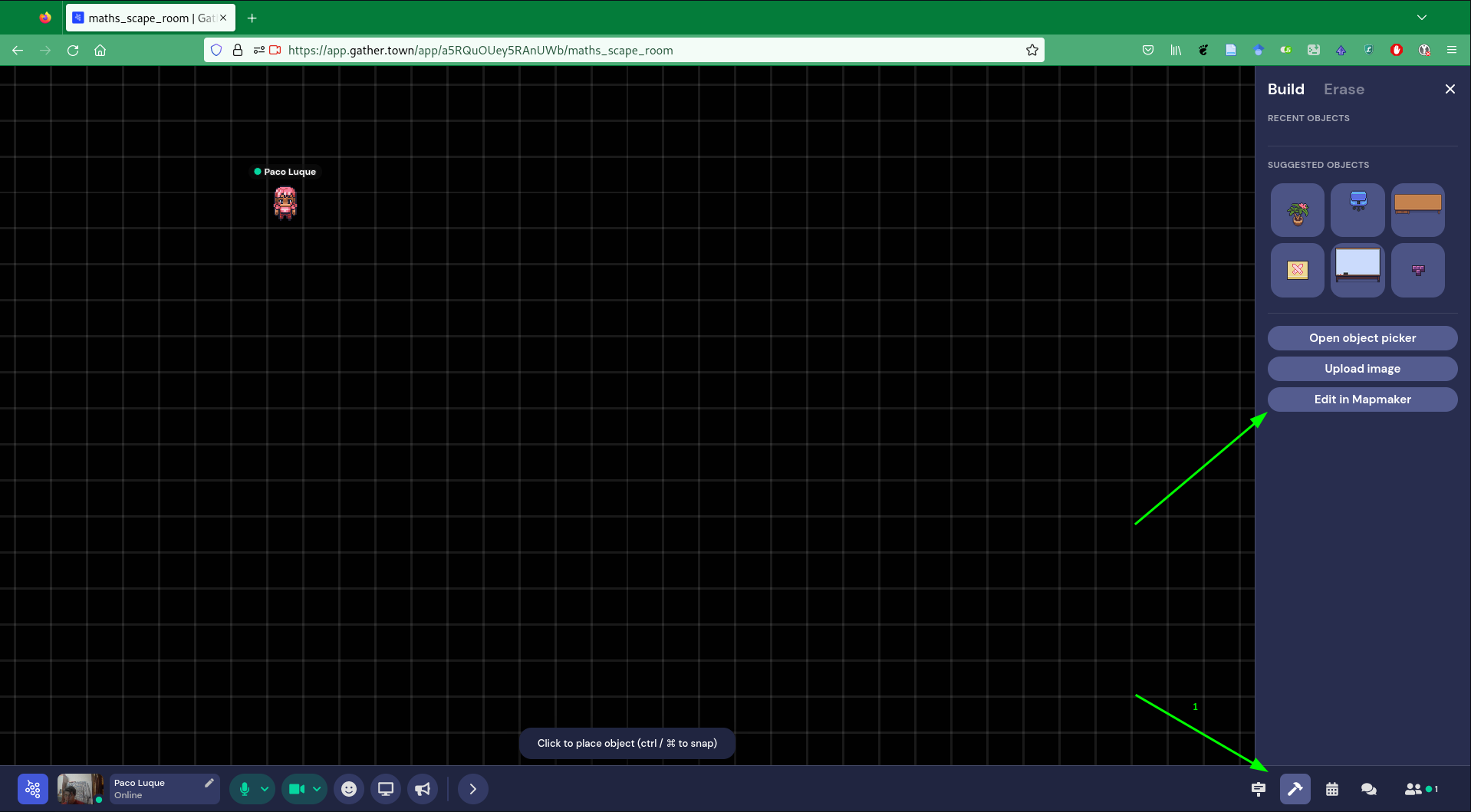
- Create the rooms for the space. You will need the following rooms:
explanation_room: The room where the game will start. It is the place where the players will begin when entering the space for the first time. You can modify the name of the default room, changing it fromblanktoexplanation_roomfirst_room_1,first_room_2andfirst_room_3: The rooms where the players will be teleported after the initial explanation (one for each player).problems_1_2: Room where the players will face the first two problems in the game.problems_3_4: Room where the players will face the problems 3 and 4 of the game.problem_5: Room for the last problem.outside: Room accessed at the end of the game.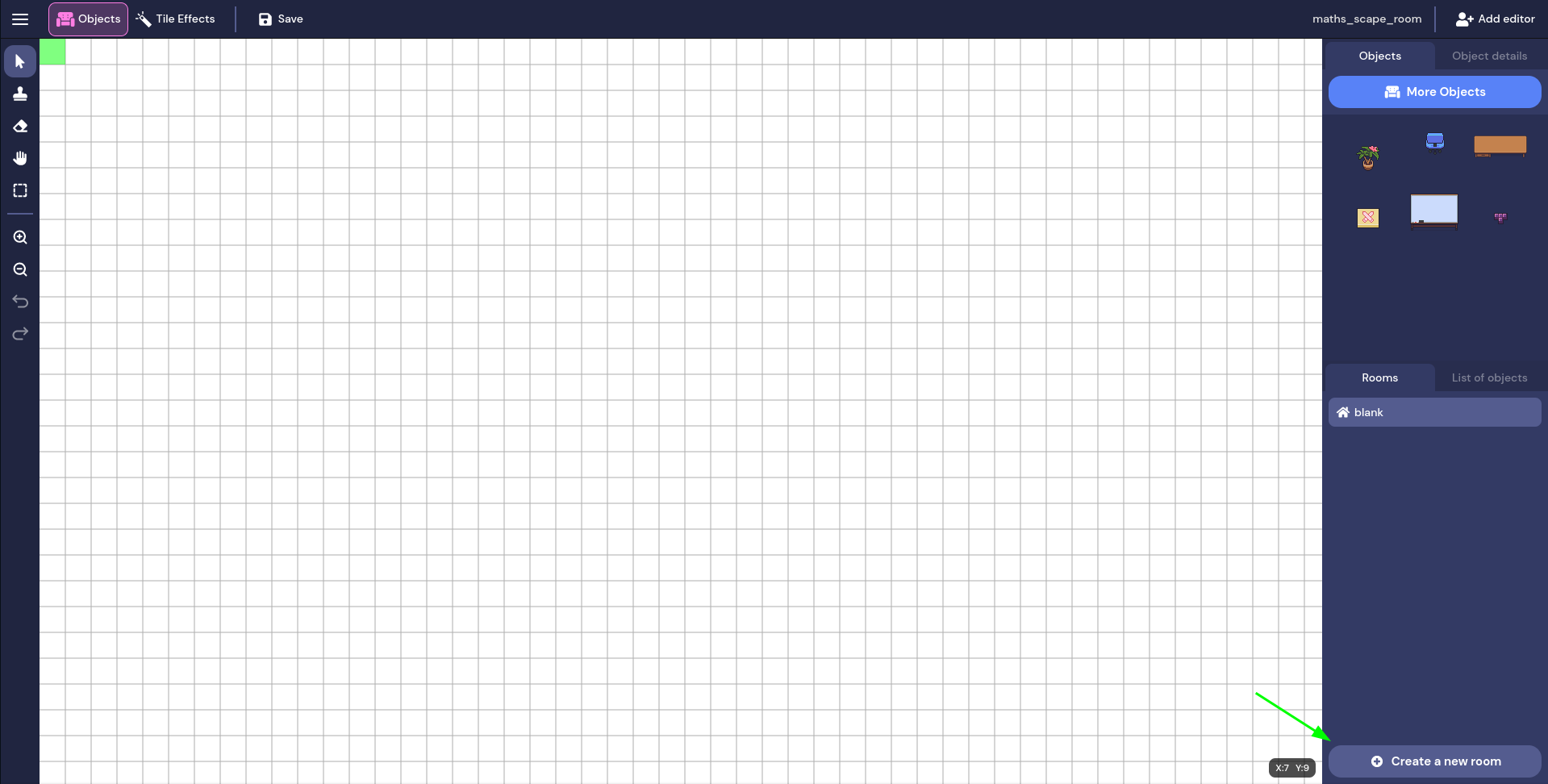
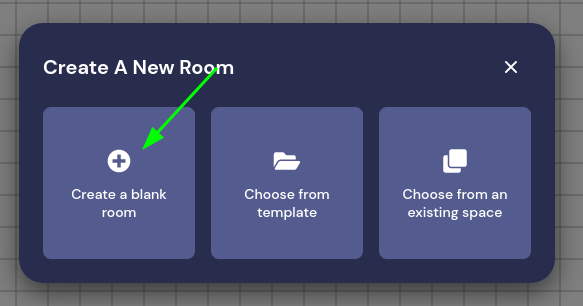
- Upload the background and foreground for each room using MapMaker.

- Set the walls as impassable tiles, and add at least one spawn tile for each
room. Only the spawn tiles in the explanation room will be used, and they have
to be placed in the left part of the room. The spawn tiles in the other maps
will not be used, but Gather Town enforces to add at least one spawn tile in
each room.
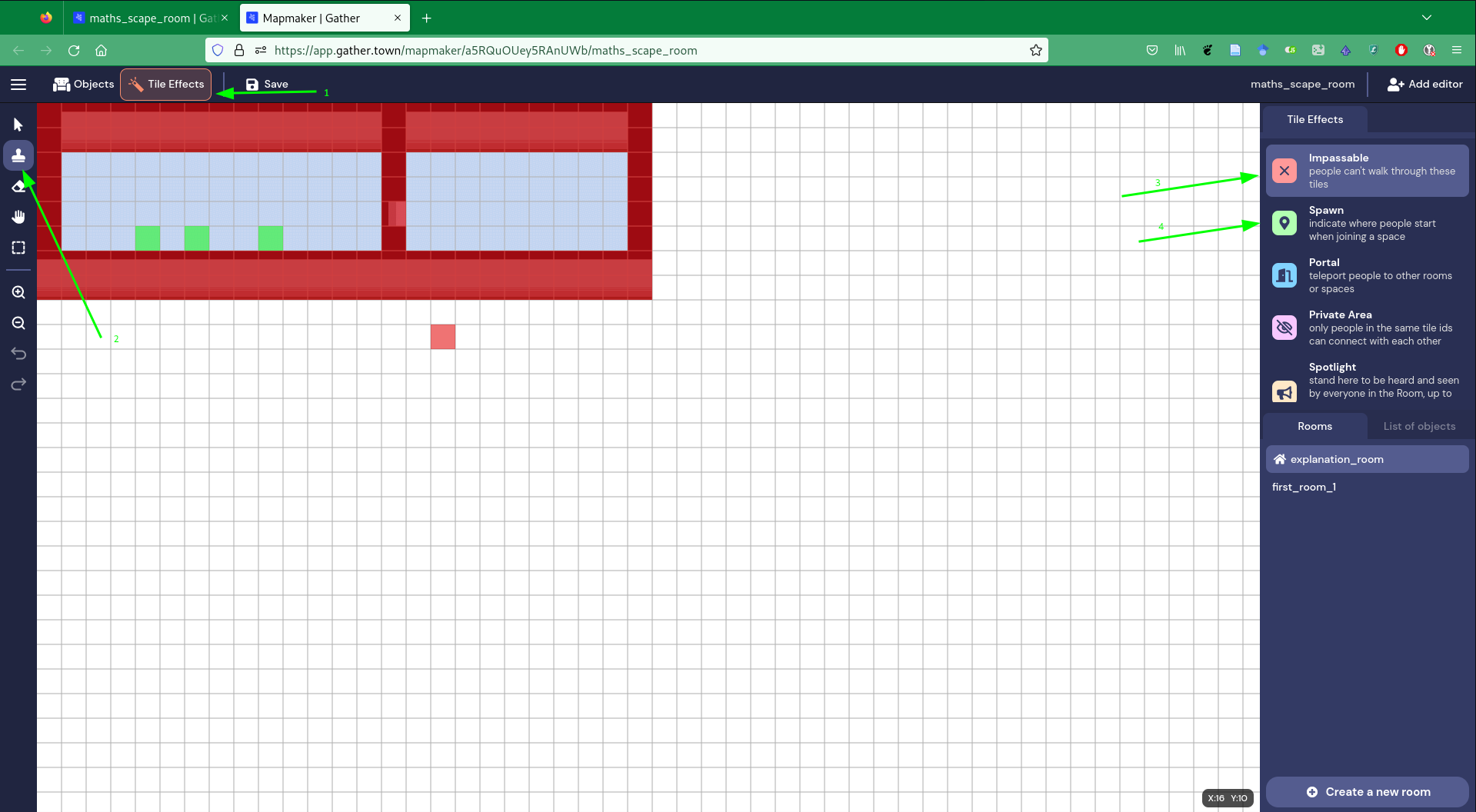
- Copy the room IDs for each room into the file
config.tsinside the foldercode. You can copy the room ID using the three dots in the right of the room name and choosing "Copy room ID".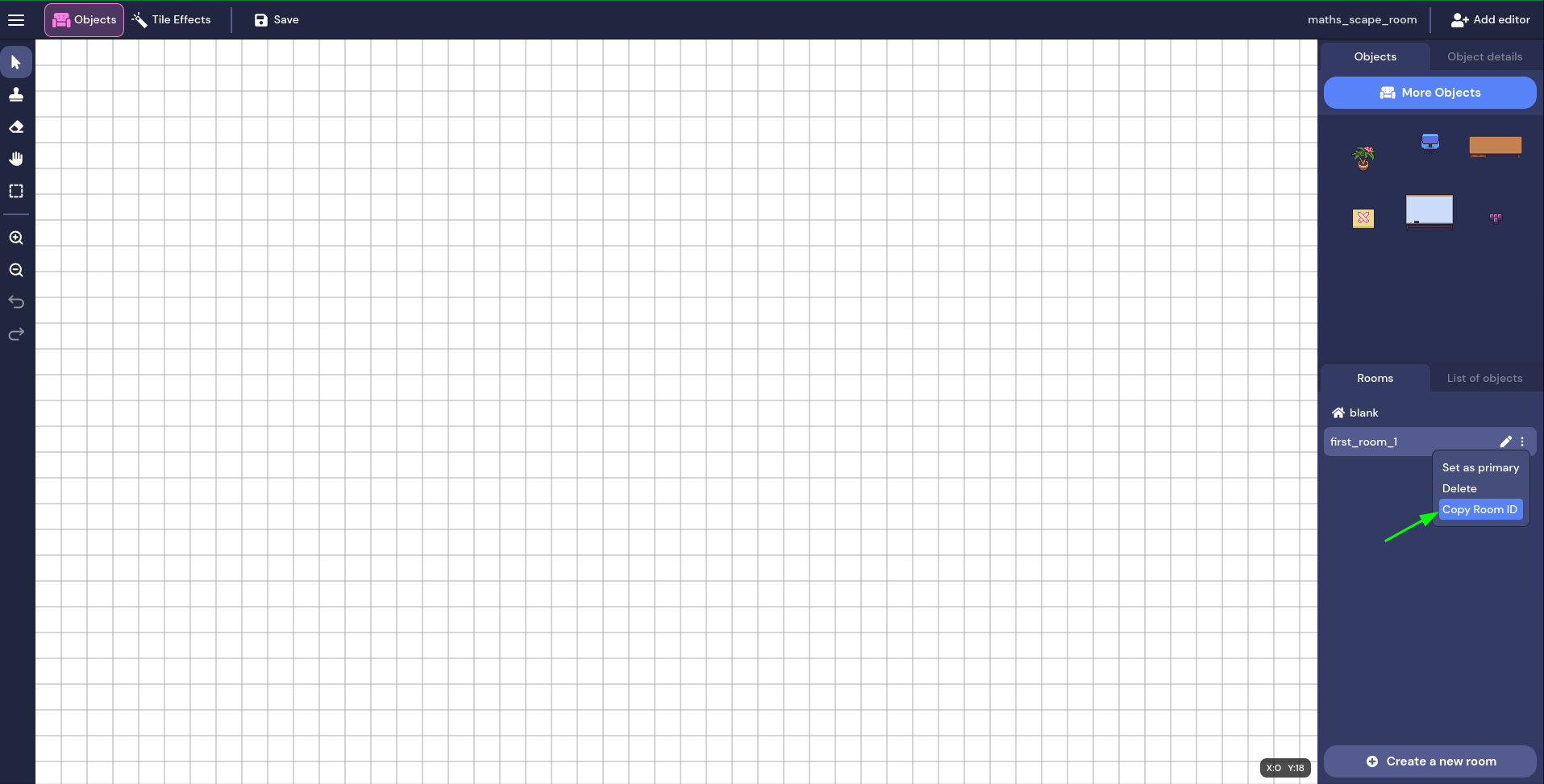
- Use the script
setup_rooms.tsin foldercodeto place the objects in the rooms. Details about how to run the script in the following section.
In order to finish the game setup, you will have to perform two additional operations to place the interactive objects and run the listeners for them. This is done using a TypeScript library provided by the Gather Town developers. You can check the docs here. There are two ways to perform this deployment:
Using docker and docker-compose
If you are familiar with docker and docker-compose, it is probably the
easiest way to perform this two steps. In order to setup the game, this steps
have to be followed:
- Make sure that configuration files are setup properly. You have to configure
file
code/.envwith information about your Gather account and space you want to modify. More information about this process in thecodefolder. Also, make sure thatcode/config.tshas the proper room IDs for your space. - Execute the following commands in a terminal, starting in the root of this
repository:
This commands will run a Docker container that places all the objects in their correct place, and prepares the teleports between rooms so the students can move in through the game rooms.
cd code docker-compose build docker-compose up gather-setup-1 - After that command is finished, use
docker-compose up -d gather-listeners-1to run the listeners for the game. You need to keep that container running to interact with the objects. If the container is not running, computers that allow the students to open the door will be unresponsive.
In order to control the room within the game, two objects have been included into the explanation room: a computer to control the blocked doors and a door blocking the access to that computer.
The computer allows the game master to open or close all the doors in the
game. Interacting with it, you can specify commands open and close to open
or close all the doors in the game. Additionally, you can specify a problem in
the second box (using problem-X to act over the problem number X) to act only
with the doors related to that problem.
The blocking door prevents the rest of the players to access to the computer
without permission. Interacting with it, you will be prompted to give a password
to open it. That password is YouShallNotPass
If you interact with the game in https://app.gather.town/app/iC2DLiAyR23qxOlS/paper_gather_town, please close all the doors in the end, so a new visitor can enjoy the game from the beginning.
